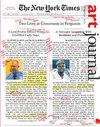Beyond a Politics of Location: On Asian/American Art Workers and Art
IF 0.3
3区 艺术学
0 ART
引用次数: 0
Abstract
What makes art “Asian”? What makes art “American”? How can ethnic, racial, and national categories be utilized in the arts without becoming essentializing? Two collections, Best! Letters from Asian Americans in the Arts, edited by Christopher K. Ho and Daisy Nam, and American Art in Asia: Artistic Praxis and Theoretical Divergence, edited by Michelle Lim and Kyunghee Pyun, confront these questions head on. Beyond a cursory overview of the ways in which one’s racial or ethnic identity and national allegiances impact art workers, these collections complicate existing labels that place art and its creators strictly within the boundaries of existing frameworks within fields spanning art history, ethnic studies, and area studies. To begin, both collections’ editors write on the centrality of the novel coronavirus pandemic, which hastened their projects into reality. The seeds of Ho and Nam’s Best! were planted in early 2020. With an open premise, they put forward a call for letters from Asian American cultural workers to “explore their Asian American identity in relationship to their practice, their upbringing, their place in the world, and their aspirations for the future” resulting in seventy-three letters of varied nature from artists, curators, professors, and others in the field (2). With this large number of contributions, the collection brings varied perspectives to the fore. And, with open-ended prompting questions provided to the writers, the content may be overwhelming at first glance. Still though each letter ranges in form and length, there are familiar kernels embedded in each: themes of diasporic identity, belonging, and intergenerational legacies which tie seemingly disparate contributions together. Published by Paper Monument, a nonprofit art press based in Brooklyn, Best! finds a home alongside texts which encourage critical thought from and for artists. Choosing to intimately tackle questions of超越地域政治:论亚裔/美国艺术工作者与艺术
是什么让艺术成为“亚洲人”?是什么让艺术成为“美国”?如何在艺术中利用民族、种族和民族类别而不变得本质化?两个系列,最好!Christopher K.Ho和Daisy Nam编辑的《亚裔美国人在艺术中的来信》和Michelle Lim和Kyunghee Pyun编辑的《亚洲的美国艺术:艺术实践与理论分歧》直面了这些问题,这些藏品使现有的标签复杂化,这些标签将艺术及其创作者严格置于艺术史、种族研究和地区研究领域现有框架的边界内。首先,两本合集的编辑都写了新型冠状病毒大流行的中心地位,这加速了他们的项目成为现实。何和南最好的种子!于2020年初种植。在一个开放的前提下,他们呼吁亚裔美国文化工作者写信,“探索他们的亚裔美国人身份与他们的实践、成长、在世界上的地位以及对未来的渴望”,从而产生了来自艺术家、策展人、教授和该领域其他人的73封不同性质的信(2)。有了这么多的贡献,这些藏品将各种各样的视角展现出来。而且,由于向作者提供了开放式的提示性问题,内容乍一看可能会让人不知所措。尽管每封信的形式和长度各不相同,但每封信中都嵌入了熟悉的内核:散居身份、归属感和代际遗产的主题,这些主题将看似不同的贡献联系在一起。由总部位于布鲁克林的非营利艺术出版社Paper Monument出版,Best!在鼓励艺术家进行批判性思考的文本旁边找到了一个家。选择密切处理
本文章由计算机程序翻译,如有差异,请以英文原文为准。
求助全文
约1分钟内获得全文
求助全文

 求助内容:
求助内容: 应助结果提醒方式:
应助结果提醒方式:


